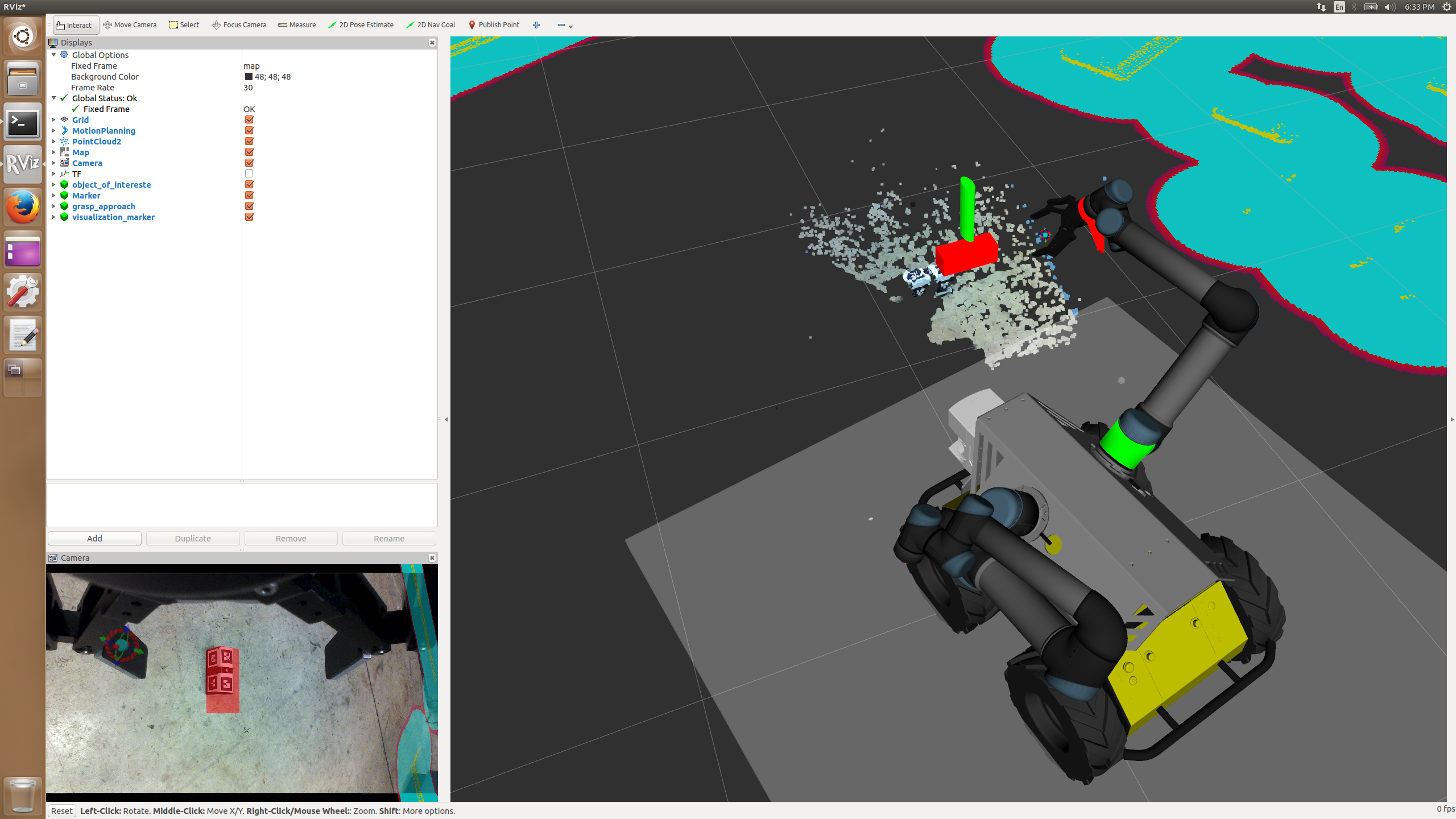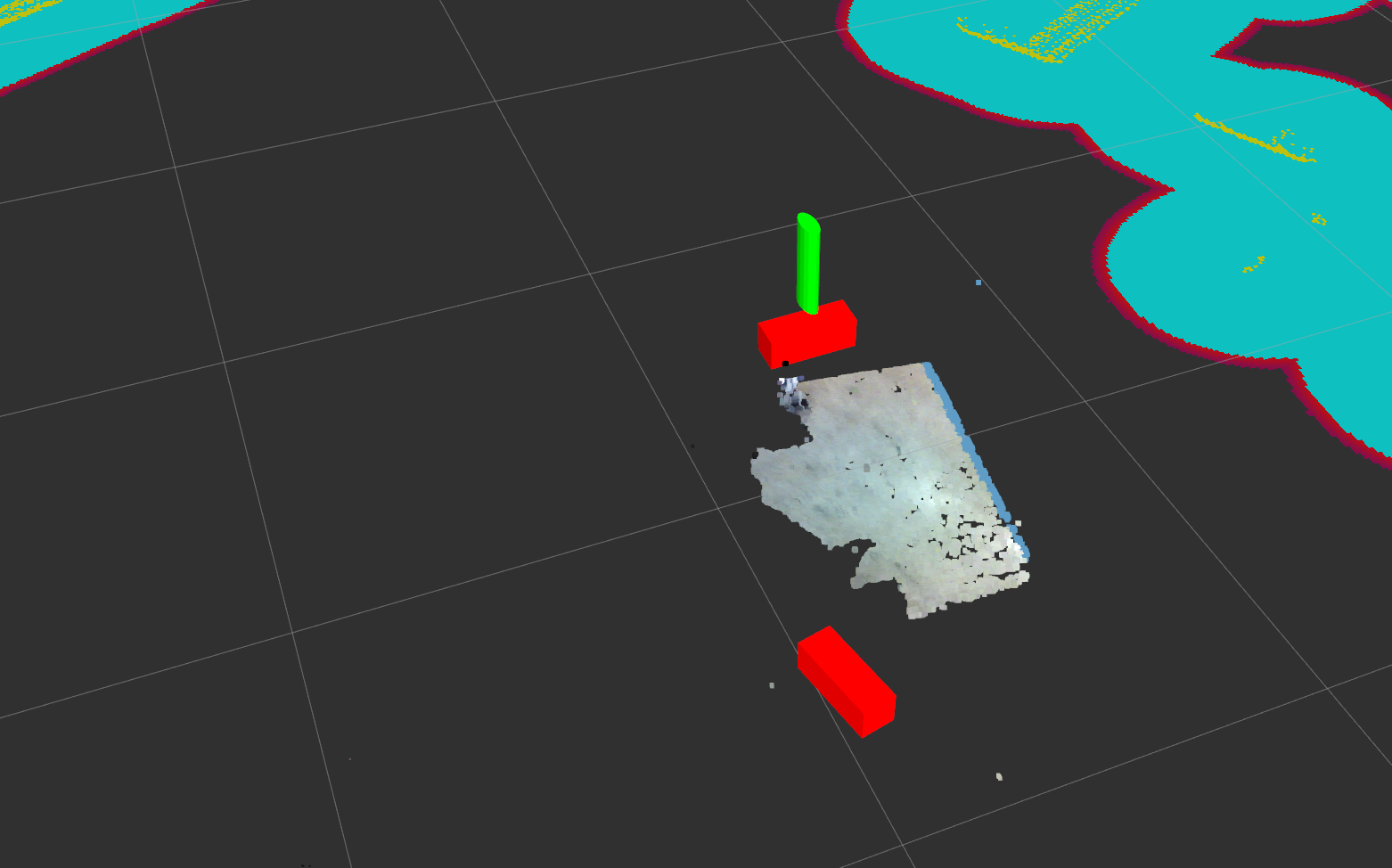Only released in EOL distros:
Package Summary
Move the robot base until a desired end-effector pose can be reached.
- Maintainer status: maintained
- Maintainer: Andy Zelenak <andyz AT utexas DOT edu>
- Author: Andy Zelenak, Andy Zelenak <andyz AT utexas DOT edu>
- License: See license.txt
- Source: git https://github.com/UTNuclearRoboticsPublic/move_base_to_manip.git (branch: indigo)
Package Summary
Move the robot base until a desired end-effector pose can be reached.
- Maintainer status: maintained
- Maintainer: Andy Zelenak <andyz AT utexas DOT edu>
- Author: Andy Zelenak, Andy Zelenak <andyz AT utexas DOT edu>
- License: See license.txt
- Source: git https://github.com/UTNuclearRoboticsPublic/move_base_to_manip.git (branch: kinetic)
Contents
Description
For mobile manipulators, this package calculates a robot base location where the end-effector (EE) can reach a desired pose (a.k.a. inverse reachability). The method is computationally fast (since it depends on a MoveIt Cartesian motion plan), simple (~300 lines), and easy to use (requiring just a service to provide the desired pose).
Below, the first image shows a mobile manipulator which is too far to grasp the object of interest. The desired EE pose is shown in green. The second image shows the freshly-calculated base position (red cube) which will allow the robot to reach that pose. <<Please ignore the bad camera calibration>>


This package uses move_base for base commands and MoveIt! for manipulator motion planning.
Installing the package
$ sudo apt-get install ros-indigo-move-base-to-manip
Run the demo
$ rosrun move_base_to_manip provide_target
^This launches a ROS service that will make a desired pose available to the move_base_to_manip node. It also displays this desired pose in Rviz. When the client sends true on the service request, this node will shut down after providing the pose.
$ roslaunch move_base_to_manip move_base_to_manip.launch
^This node requests the desired pose from the other node. It then moves the end-effector to the desired height and orientation. From there, it plans a Cartesian move to the desired pose. The % completion of the Cartesian move informs the base on how far it must move. If the Cartesian move is able to complete 100%, the arm moves and the program exits. Otherwise, there is a call to move_base to get closer to the object:
ac.sendGoal(goal);
At this point, your robot base should move.
Parameters
The planner reads optional parameters on the ROS parameter server. They can be adjusted from the command line, programmatically, or left as their default values. They are:
* /move_base_to_manip/motion_buffer: A fraction between 0 and 1. A value of 1 means the EE will barely be able to reach the desired pose when fully extended. A value of 0 means the base motion will bring the EE to the desired pose without additional arm motion. Default: 0.15.
* /move_base_to_manip/move_cartesian: Use a Cartesian motion for the final arm approach, or a regular MoveIt motion? The Cartesian motion may be useful if your task requires the gripper to maintain a constant orientation (like grasping often does). Default: false, i.e. do a regular motion.
* /move_base_to_manip/clear_octomap: Clear the octomap collision scene before the final arm approach? This is often necessary for grasping -- otherwise sensor noise/resolution may lead the robot to expect a collision. Default: true, i.e. the collision scene will be cleared.
* /move_base_to_manip/clear_costmaps: Clear the move_base costmaps before base motion? Default: true.
* /move_base_to_manip/prompt_before_motion: Ask the user before making any motion? This is useful if you're just starting to use the package and aren't sure what to expect. Default: true.
* /move_base_to_manip/shutdown: This is the "request" part of the service call. Can be used as a signal that the server can shutdown. Default: true (which I use to signal the pose provider node to shut down).
* /move_base_to_manip/cartesian_plan_res: A smaller number results in a more accurate prediction of the distance to the pose of interest. Default: 0.005m
* /move_base_to_manip/move_group_name: Default "right_ur5"
* /move_base_to_manip/move_group_planner: Default "RRTConnectkConfigDefault"
* /move_base_to_manip/velocity_scale: % of maximum robot speed for all arm motions. Default: 0.1
* /move_base_to_manip/base_frame_name: Default "base_link"
* /move_base_to_manip/position_tolerance: Position tolerance for arm motions. It may be useful to bump this up if you are having trouble finding plans. Default: 0.01 m
* /move_base_to_manip/orientation_tolerance: Orientation tolerance for arm motions. Default: 0.0001 rad
* /move_base_to_manip/ok_to_flip: If true, the planner will try to flip the EE +/-180 deg about Z (i.e. yaw) when it cannot reach a desired pose. Then it will attempt to plan again. Useful for 2-finger grippers. Default: true
Tuning move_base
Here are some hints to get more suitable trajectories from move_base:
* Make sure the resolutions of your costmap and move_base planners are fine enough to get the accuracy you require.
* If you see excessive spinning, make sure oscillation_timeout is set to a nonzero value..
* Remember, there are two controllers to tune: local and global.
* Make sure the inflation_radius is the same for both local and global planners.
Here are more hints from the creator of move_base.
Limitations
This package only calculates one base position which can reach the desired pose. If the base is not able to move there, it fails. However, move_base has some built-in obstacle avoidance capabilities and if it fails, it will generally be close to the goal.
See Also
Some potential ROS alternatives for mobile manipulation planning:
* (untested) Use the Reuleaux package to calculate a good location for the manipulator's base. From the manipulator's position, calculate a mobile base location. This is the "inverse reachability database" approach.
* (untested) It might be possible to model a robot base as 3 joints of a manipulator (x,y,theta) and add it to the kinematic model of the robot. Then an inverse kinematics solver could be used to plan the base and arm motion all at once.
* (outdated) DARRT - seems more feature-rich but also more computationally intensive.







